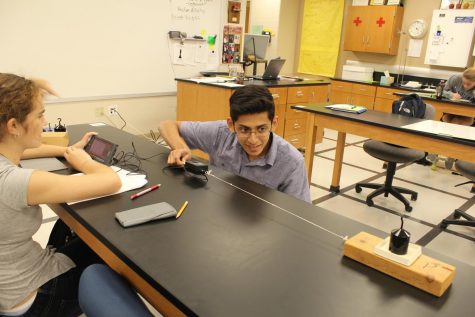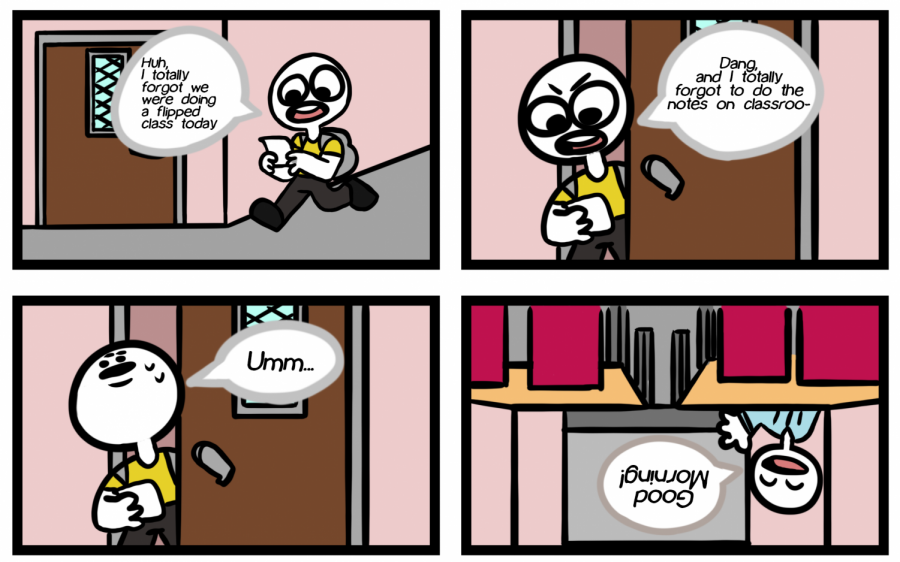Your donation will allow our student journalists to continue their work. You may become a PATRON by making a donation at one of these levels: White/$30, Black/$50, Gold/$100. Patron names will be published on the website and once per quarter on our social media accounts.
Flipped classrooms turn tables for student learning
October 19, 2018
Rockwood has recently been focusing on intertwining technology with education ranging from the introduction of Chromebooks to usage of Google classroom, as well as utilizing other applications through them. Long before this program even began, teachers introduced technology to the classroom in a different way, through flipped classrooms. The basic structure a flipped classroom include teachers assigning video lectures as homework while the practice problems are completed during class.

Taylor Bridge, senior, reads the instructions on the lab sheet to determine her groups’ next step.
Lafayette teachers make move to innovative teaching method
Rockwood has recently been focusing on intertwining technology with, education ranging from the introduction of Chromebooks to usage of google classroom, as well as utilizing other applications through them. Long before this program even began, teachers introduced technology to the classroom in a different way, through flipped classrooms. The basic structure a flipped classroom include teachers assigning video lectures as homework while the practice problems are reviewed during class.
Many well known corporations participate in the rise of flipped classrooms by providing educational video content. A notable example would be Khan Academy, a non profit website that provides a multitude of education videos in subjects from math to history.
In 2017, Khan Academy and the College Board conducted a study showing that 20 hours of practice using the sites official Scholastic Assessment Test (SAT) questions, is associated with a 115 point average score increase from the Practice Scholastic Assessment Test (PSAT) to the SAT, nearly double the average gain of students who do not use this practice.
While there being such large, successful corporations available to help establish flipped classrooms, teachers in our school typically create their own videos for their classes to utilize and send them out via google classroom. One of these teachers is science teacher Shannon Campbell, who teaches chemistry and AP Physics 1-2. She started flipping her classroom four years ago when the AP Physics format changed.
“We found that students needed more time discussing material, and with the conventional format of lecturing in classes and then taking notes there wasn’t a lot of time to work on problems together or to talk about material,” Campbell said.
She assigns videos to her classes weekly, and usually assigns around two per week for each of the three classes she teaches. She notes that video lessons have improved her students grades and AP scores overall.
According to a survey of about 500 teachers conducted by the Flipped Learning Network showed that around 90 percent of teachers using the technique were happier about their jobs and 67 percent had increased student test scores. However these rising test scores do not come without a price.

“It’s a lot more work on the teacher because you have to make the videos,” Jennifer Keillor, a Human Anatomy teacher, said. “But what’s good about that is it’s a lot of work up front but it allows you to have so much more time one-on-one with each student which is really what you want.”
Similar to Campbell’s reason for change, Keillor began to utilize flipped classrooms five years ago in her Human Anatomy classes for various reasons.
“I felt like there was an issue with the amount of material we had to get through and the amount of notes kids have to take. I was spending so much time lecturing so the kids weren’t getting to do a lot of hands on activities,” Keillor said.
Lecture-heavy classes are common in schools for the majority of subjects. Despite this, not many teachers at our school use flipped classrooms.
“I think flipped classrooms can be really ineffective if a teacher doesn’t use it correctly,” Campbell said.
The intention of a flipped classroom is to assign video lectures at home and then apply the lecture notes in class. This format seems to work better in some classes than in others.
Student opinion varies on flipped class teaching format
Lucas Ortman, junior, is currently enrolled in Shannon Campbell’s AP Physics one class, his first flipped classroom.
“I like the flipped classroom. I get to review the notes as I’m learning them and then we have more time in class to have questions for the teacher,” Ortman said.
In his physics class, usually a video lesson is assigned a few times a week along with guided notes. Next class period, Campbell answers any questions the students may have about the online lesson, then they begin working on homework and practice problems all together.
Typically, a teacher only uses flipped classrooms for math and science. Physics is the only class Ortman is enrolled in where a flipped environment is used. Although Ortman has had a positive experience with the new style, he said he would not want it for some subjects, like a world language.
Rachel Paese, junior, is currently enrolled in Human Anatomy Flex with Jennifer Keillor, who uses a flipped classroom. Paese has previously been introduced to this new outline in her seventh grade math class.
“I think math and Anatomy with flipped classroom is a lot different just because what you’re learning and the way you’re learning it is very different. Personally, I don’t love the flipped classroom for Anatomy because it’s hard for me to retain the information through a video,” Paese said.

Some students, like Paese, are more visual and struggle with paying attention to the voice-over lessons.
“Just listening to someone speak is a lot harder for me than like actually doing something… [To make up for the lack of visual learning] I just ask for clarifications or we do a lot of helpful graphic organizers and coloring sheets and stuff like that,” Paese said.
Paese believes other students in the same anatomy class are also struggling. There’s more responsibility to keeping up with all the video lessons and confronting the teacher with questions if there’s any confusion with the subject.
While some students such as Paese are having issues with the class, there are advantages to this structure. Due to the fact that the lessons are given at home, students can watch the video(s) numerous amounts of times until they have really grasped the necessary information or are at least able to understand and complete the given guided notes assigned by the teacher.

